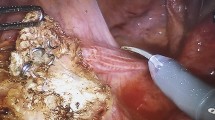Abstract
Background
This study aimed to compare ventral mesh rectopexy (VMR) and pelvic organ prolapse suspension surgery (POPS) in management of patients presenting with rectal prolapse.
Methods
Our study was a prospective cohort trial in which 120 female patients with complete rectal prolapse were included, 60 patients had had VMR and the other 60 had had POPS as a surgical management for complete rectal prolapse. Results had been compared 6 months postoperatively regarding operative time, postoperative pain, hospital stay, complications of surgery including recurrence of the rectal prolapse, the efficacy of each operation in treatment of rectal prolapse and associated symptoms.
Results
The patients were assessed 6 months postoperatively. There was no significant statistical difference regarding hospital stay and postoperative pain. Operative time was significantly shorter in POPS in comparison with VMR (P value < 0.05). VMR showed slight improvement regarding constipation and continence scores; however, this was statistically significant. VMR showed less complications compared to POPS. Complications with rectopexy happened only with 4 patients compared to 24 patients in POPS groups, 2 cases of recurrence in rectopexy group compared to 6 cases of recurrence in POPS.
Conclusion
POPS is comparable to VMR in management of rectal prolapse and in improving the ODS symptoms. Thus, POPS can be used as easier, faster option to treat rectal prolapse in selected patients.




Similar content being viewed by others
References
Varma M, Rafferty J, Buie WD (2011) Practice parameters for the management of rectal prolapse. Dis Colon Rectum 54:1339–1346
Brooke Gurland and Massarat Zutshi (2016) Rectal prolapse The ASCRS textbook of colon and rectal surgery, 3rd edn vol. 60 :1077–1089
Ceci F, Spaziani E, Corelli S, Casciaro G, Martellucci A, Costantino A, Napoleoni A, Cipriani B, Nicodemi S, DI Grazia C, Avallone M, Orsini S, Tudisco A, Aiuti F, Stagnitti F (2013) Technique and outcomes about a new laparoscopic procedure: the pelvic organ prolapse suspension (POPS). G Chir 34(56):141–144
Jorge JMN, Wexner S (1993) Etiology and management of fecal incontinence. Dis Colon Rectum 36:77–97
Agachan F, Chen T, Pfeifer J, Reissman P, Wexner SD (1996) A constipation scoring system to simplify evaluation and management of constipated patients. Dis Colon Rectum 39(6):681–685
Emile SH, Elbanna H, Youssef M, Thabet W, Omar W, Elshobaky A, Abd El-Hamed TM, Farid M (2017) Laparoscopic Ventral mesh rectopexy vs Delorme’s operation in the management of the complete rectal prolapse, a prospective randomized study. Colorectal Dis 19(1):50–57
Senapati A, Gray RG, Middleton LJ, Harding J, Hills RK, Armitage NC, Buckley L, Northover JM (2013) PROSPER Collaborative Group. PROSPER: a randomised comparison of surgical treatments for rectal prolapse. Colorectal Dis. 15(7):858–868. https://doi.org/10.1111/codi.12177
Emile SH, Elfeki H, Shalaby M, Sakr A, Sileri P, Wexner SD (2019) Outcome of laparoscopic ventral mesh rectopexy for full-thickness external rectal prolapse: a systematic review, meta-analysis, and meta-regression analysis of the predictors for recurrence. Surg Endosc 33(8):2444–2455
Yoon S-G (2011) Rectal prolapse: review according to the personal experience. J Korean Soc Coloproctol 27(3):107–113
Badrek-Al Amoudi AH, Greenslade GL, Dixon AR (2013) How to deal with complications after laparoscopic ventral mesh rectopexy: lessons learnt from a tertiary referral centre. Colorectal Dis 15:707–712
Maher CF, Qatawneh AM, Dwyer PL, Carey MP, Cornish A, Schluter PJ (2004) Abdominal sacral colpopexy or vaginal sacrospinous colpopexy for vaginal vault prolapse: a prospective randomized study. Am J Obstet Gynecol 190(1):20–26
Geomini PM, Brölmann HA, van Binsbergen NJ, Mol BW (2001) Vaginal vault suspension by abdominal sacral colpopexy for prolapse: a follow up study of 40 patients. Eur J Obstet Gynecol Reprod Biol. 94(2):234–238
Smart NJ, Pathak S, Boorman P, Daniels IR (2013) Synthetic or biological mesh use in laparoscopic ventral mesh rectopexy–a systematic review. Colorectal Dis 15:650–654
Acknowledgements
This directed to Faculty of medicine, Cairo University, who completely funded this research.
Author information
Authors and Affiliations
Corresponding author
Ethics declarations
Conflict of interest
The authors declare that there is no conflict of interest
Ethical committee approval
The study was approved by the Research Ethics Committee of Cairo University.
Informed consent
Informed consent was obtained from all individual participants included in the study
Additional information
Publisher's Note
Springer Nature remains neutral with regard to jurisdictional claims in published maps and institutional affiliations.
Appendix A
Appendix A
Preoperative preparation: All patients were given enema at the night before the operation and one hour before the operation; patients were risk assessed for thromboembolic events and prescribed thromboembolic deterrent (TED) stockings and low molecular weight heparin as appropriate, the administration of which is determined after the surgical procedure. Prophylactic antimicrobials were administered at induction; in our unit, amoxicillin 1 g, metronidazole 500 mg (ideal body weight) IV are given to non-penicillin allergic patients.
Rights and permissions
About this article
Cite this article
Farag, A., Mashhour, A.N., Raslan, M. et al. Laparoscopic Pelvic Organ Prolapse Suspension (Pops) Versus Laparoscopic Ventral Mesh Rectopexy for Treatment of Rectal Prolapse: Prospective Cohort Study. World J Surg 44, 3158–3166 (2020). https://doi.org/10.1007/s00268-020-05585-0
Published:
Issue Date:
DOI: https://doi.org/10.1007/s00268-020-05585-0




